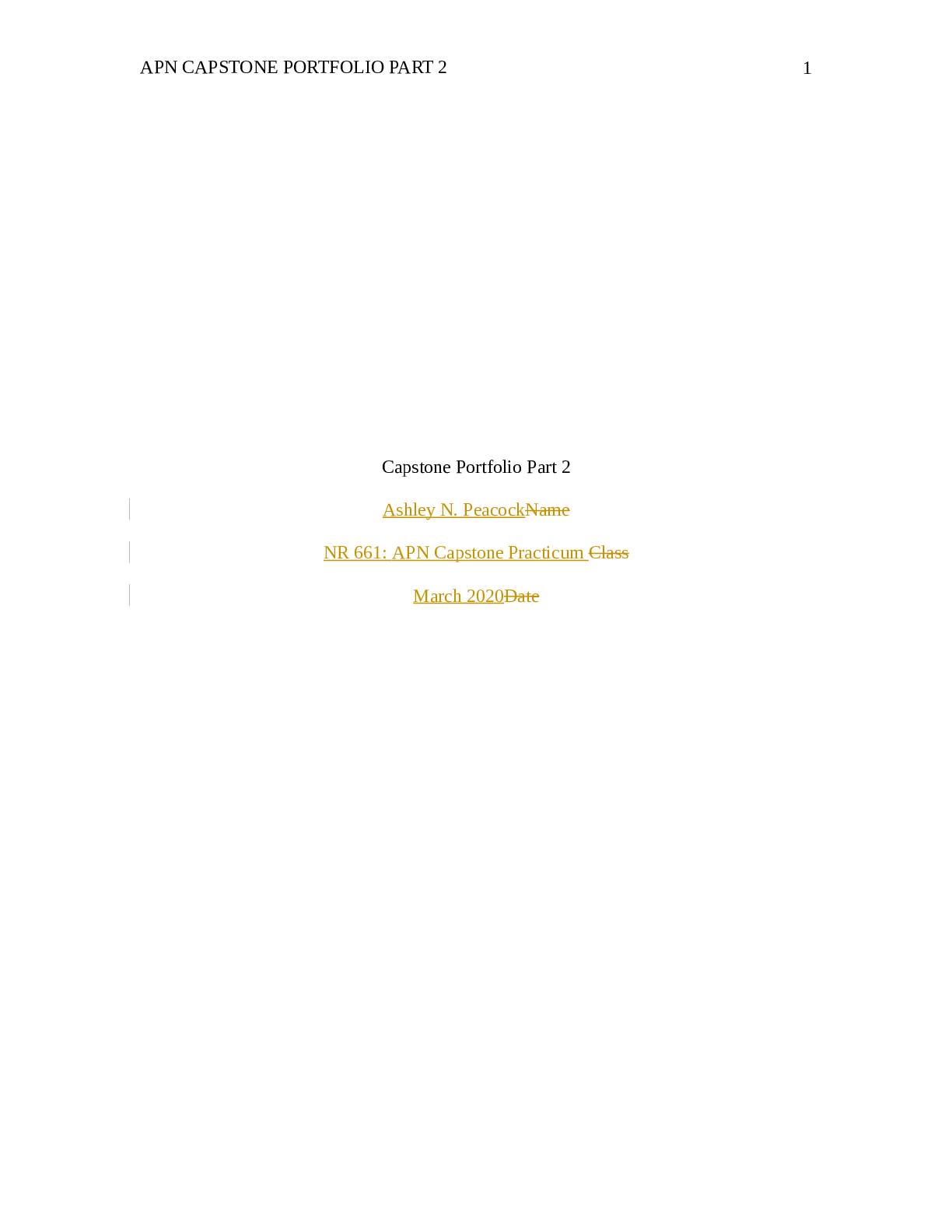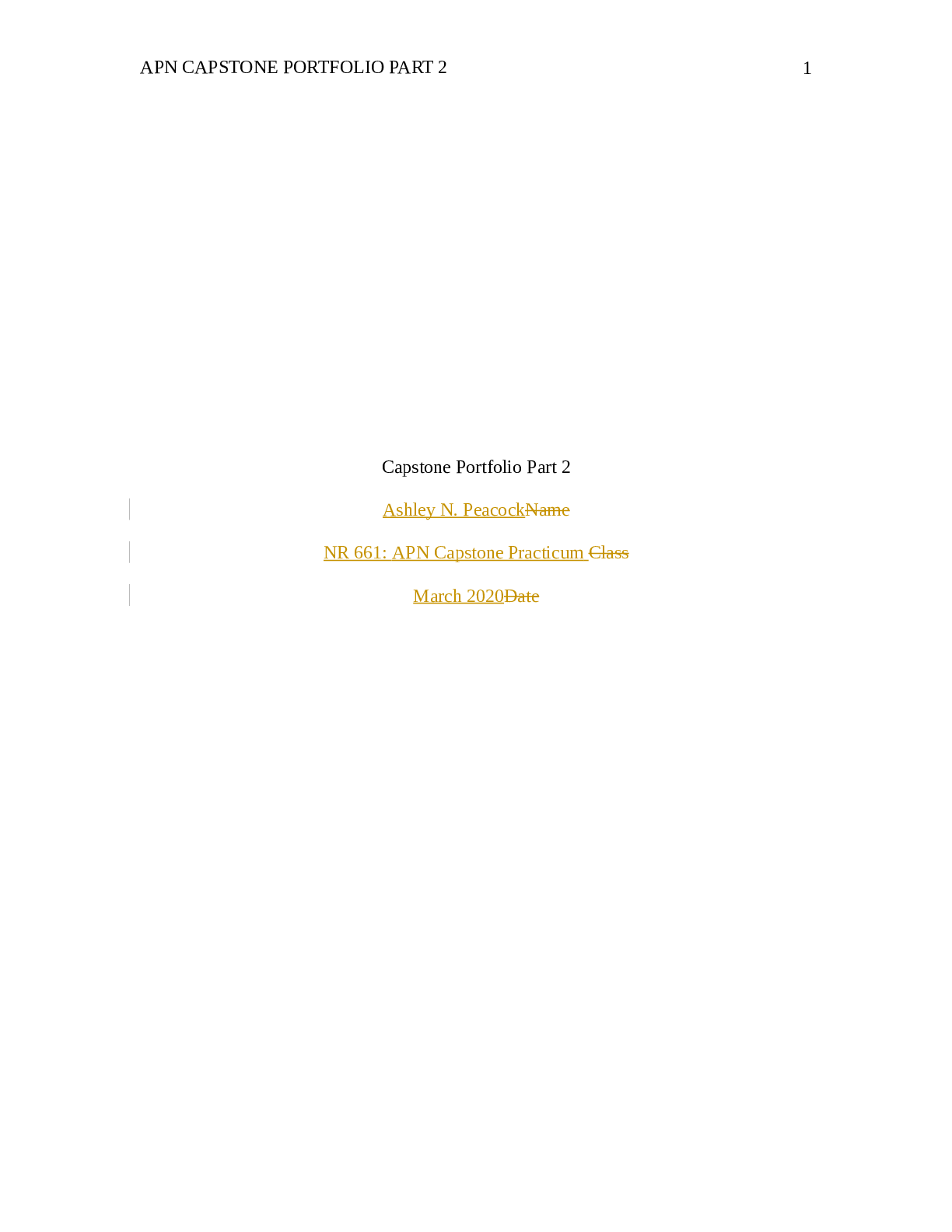he purpose of this APN Capstone Portfolio is to highlight my professional
growth and expertise by providing evidence of the knowledge I have learned. This paper
will demonstrate how IWrite an introduction paragraph that introduces the topic of your
paper and summarizes the key points that will be discussed. Hint: state that you have met
Chamberlain University’s program outcomes (PO), the Essentials of Master’s Education
(MSN Essentials), and the National Organization of Nurse Practitioner Faculties
(NONPF) Core Competencies. I State that this paper will identify and explain how you
have met each of these objectives were met by providing exemplars of myyour graduate
work, reflect on how meeting these objectives have transformed meyou into a
prospective masters-prepared nurse, and present how the concepts from your work
interrelate.
Exemplar 1: NR500 Week 3 Addressing Bias PaperWrite the Name of the Piece of
Work
Copy the exemplar here. Although experiences can shape our development of a
bias mindset; it can be challenging to not permit these biases to affect how we interact
and care for patients. By analyzing and reaffirming our personal biases during the week 3
paper assignment I was able to be better prepared to be a leader with integrity and self-
awareness to provide optimal care to all patients. Self-awareness is a process of objective
examination of oneself and is one of the important components in nurse-client
relationship. Addressing bias is an important step in creating self-awareness. Although
experiences can shape our development of a bias mindset; it can be challenging to not
permit these bias thoughts to affect how we interact and care for patients.APN CAPSTONE PORTFOLIO PART 2
4
TThis attribute reflects the cognitive exploration of own thoughts, feelings,
beliefs, values, behaviors, allows one to understand nd how they can affect others
(Rasheed, 2015). Therefore, it is critical that if any negative attitudes toward any patient
strategies must be developed toand utilize to eliminate them. This paper also allowed me
to develop such strategies to use to ensure I am not being bias towards any patient. For
example, at the end of each day on the drive home I self-reflect on the care I provided my
values, behaviors, feelings, and thoughts of how I would feel if I was the patient so that I
could provide better care the following day.
This paper also allowed me to reflect on unconscious stereotyping and prejudice
contribute to healthcare disparities to advocate for fairness and the elimination of such
negative behavior and mindsets. According to Philip, Chadee, and Yearwood (2014),
study found that in Trinidad and Tobago discrimination is still present especially against
people diagnosed with HIV/AIDS and at-risk groups. This negative attitude therefore
creates barriers to accessing important testing and treatment services. Another study
sought the view from nurses of what it means to provide care to the obese. Marques, De
Melo, and Dos Santos (2014), study also found several bias and negative attitudes toward
obese patient that included: being obese is excessive, it is not healthy; Providing care to
the obese is a structural issue; Obese patients are troublesome, they require care, no big
deal; Providing care to the obese requires teamwork. These negative views can interfere
in the care provided and vital to eliminate as advanced practice nurses.
This reflective paper also allowed me to understand, value cultural differences,
and the importance of cultural competence. As we move to increasingly diverse society;
the U.S. Census Bureau projects that the United States will be a majority-minority nationAPN CAPSTONE PORTFOLIO PART 2
5
by 2043, and bBeing cCultural competence is vital. Cultural competencethrough training
also encompasses the needed knowledge about diverse people and their needs, attitudes
that recognize and value difference, and flexible skills to provide appropriate and
sensitive care to diverse populations (Kools, Chimwaza, & Macha, 2015).
Organizations that wish to stay relevant in a society with rapidly changing demographics
are learning that organizational cultural competence is the first step in reaching and
employing diverse audiences. Cultural competence also enables effective teamwork in
cross-cultural communities or programs by giving individuals and organizations the
framework for operating in varying cultural contexts. Culturally competent organizations
are equipped to work with people who have different backgrounds, attitudes, and
worldviews thus building a larger, more powerful organization (Mcmullen-Bushman,
2017). constituency
Identify and Explain
This exemplar shows evidence that I have met program outcome number #3
engage in lifelong personal and professional growth through reflective practice and
appreciation of cultural diversity. By completing the week 3 addressing bias paper I was
able to not only reflect on and identify bias thoughts that I may hold or that may be seen
in practice to effectively strategize to eliminate them to prevent any hinderance in care to
any patient. By reflecting daily on my personal values, beliefs, and attitudes that I may
hold to develop steps to ensure that I am not being bias to any patient under my carAPN CAPSTONE PORTFOLIO PART 2
6
services. As new graduate advanced practice nurse this is a vital step to be an effective
role model, successful career, and business.
MSN Essentials III: Quality Improvement and safety was also met through the
completing of the reflective paper on addressing bias; I was able to understand the
importance of self-awareness, holding bias ideas, and the importance of eliminating such
ideas in the healthcare environment through daily self-reflection of my personal
interaction with patient and staff members, my values, belief and attitudes. Self-reflection
allows the identification of any bias ideas that may hinder care and direct quality
improvement methods to promote culturally responsive, safe, timely, effective, efficient,
equitable, and patient-centered care therefore meeting this master’s essential (AACN,
2011).
Read More


